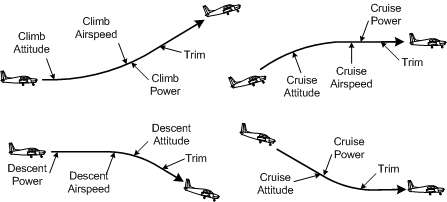CLIMBS AND DESCENTS
Aim
Students must demonstrate the ability to produce and control climbs and descents.
Description
While climbs and descents are not specific flight test items, you must demonstrate the overall ability to conduct smooth and accurate altitude changes using a safe and organized set of procedures, while maintaining an appropriate and constant airspeed.
Performance Criteria
This exercise is not a flight test item, but is evaluated in conjunction with other exercises; Private Pilot Students and Commercial Pilot Students must
- complete appropriate safety precautions before conducting a climb or descent;
- demonstrate smoothness in control;
- demonstrate correct sequence of pilot action;
- maintain airspeed within ± 10 KNOTS of target;
- maintain heading within ± 10° of target;
- upon completing the climb or descent, maintain altitude within ± 100’ of target.
Discussion
Climbs are initiated in accordance with the acronym AAPT—i.e., “AAPT to climb,” while descents are flown with the acronym PAAT—i.e., “PAAT to descend.” In both case, “A” stands for either “attitude” (pitch attitude) or “airspeed,” “P” stands for “power” (throttle) setting, and “T” stands for trim (proper trimming of the aircraft). These proper sequences are basic and crucial to flying and you want to be sure to get them right.
To initiate a climb, the acronym first requires that you place the aircraft in a climb attitude (AAPT)—be precise with respect to the placement of the glareshield. As you raise the nose you will have to use rudder to correct yaw movement (the footwork should be smooth, gentle, yet firm). Then, as the aircraft slows and the airspeed reaches to within 10 MPH of the target climb airspeed (AAPT), smoothly apply full power (AAPT)—power changes will of course require additional yaw control, again smooth, gentle, and yet firm. Finally, trim (AAPT), being sure that you trim off all control column pressure (for hands-free flight) while simultaneously holding the nose aggressively in the climb attitude. To level off, climb to slightly above your target altitude—perhaps 20’. Then apply the acronym again—AAPT: smoothly place the aircraft in the cruise attitude, allow the aircraft to accelerate to the desired cruise speed before bringing the throttle back to the cruise setting, and then trim for hands-free flight—again being sure you maintain the proper pitch with the left hand until the trimming process is completed.
To descend, use “PAAT.” Smoothly reduce power to the target reduced power setting (PAAT). As the power is reduced, use your feet to keep the nose straight and simultaneously adjust the aircraft pitch to maintain altitude until the targeted airspeed (PAAT) is reached. This is important—keep the aircraft level at the initial altitude until it slows to the descent speed. When the airspeed slows to the target speed, gently pitch forward (attitude—PAAT) sufficiently to maintain the speed—again rudder control will be required as the pitch is changed. Finally adjust the trim (PAAT) to maintain the descending speed hands-free. When the target altitude is reached the cruise power setting should then be re-established with the throttle and the pitch adjusted to the cruise attitude—while this is being done footwork will of course be required. Finally, re-trim for hands-free flight in the cruise attitude. When you level out after a climb or descent, be sure you perform the “cruise checks.” If descending, ensure that the mixture is advanced, either before or during the descent. Flaps are sometimes selected during descent—on final approach, for example. In such cases, the flaps are selected after the power reduction occurs, and prior to trimming. During climbs, the obstacle clearance flap setting is sometimes used, and you want to become precise at pitch and airspeed control. All flap changes should be done smoothly without allowing the nose to flop about. When recovering (retracting) the flaps during a climb, ensure the pitch is properly adjusted first.

Flight Safety
The risk of collision is high during a climb or descent, so ensure you apply clearing turns in the climb, and always make a gentle turn prior to and during a descent to ensure other aircraft are not below you.
.jpg)

